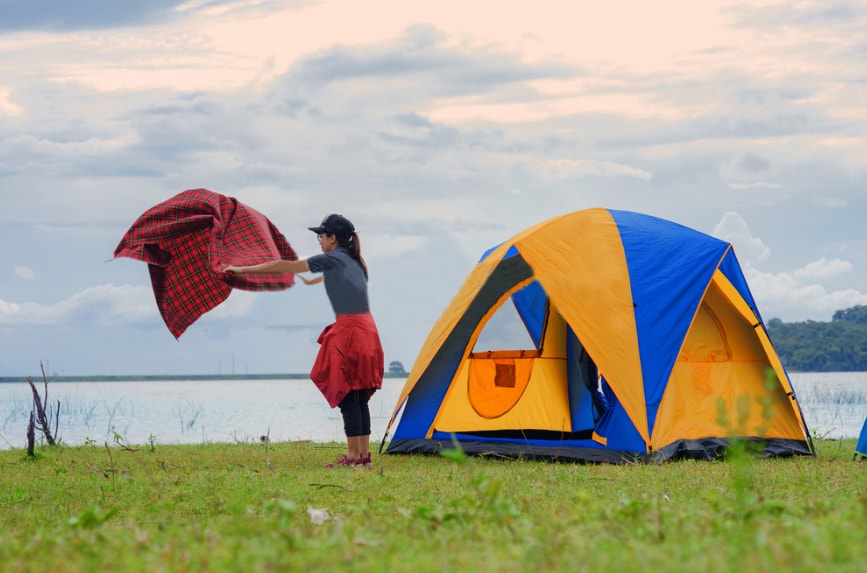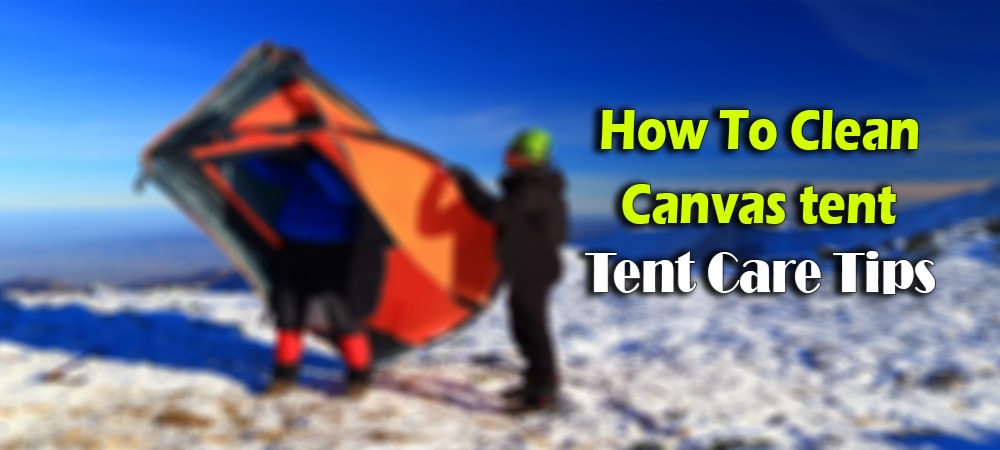How To Clean Canvas Tent – Tent Care Tips
Purchasing a canvas tent is an investment in comfort and convenience. It is important to know how to clean a canvas tent so it will last for many years. Dust, dampness and other debris can shorten the lifespan of the fabrics and other materials. When properly maintained, your canvas tent will serve you for much longer. Canvas is a material that is different than polyester or many of the newer fabrics and it must be cared for differently. This guide will give you all the information that you need to do the job the right way and preserve the usability of your canvas tent. In this article, we will show how to clean canvas tent with full details guideline.
How do I clean or wash my tent?
Canvas is a resilient and sturdy fabric that is thicker than the polyester blends, but it is also subject to the effects of dust and water contamination. Mold and mildew develop quickly, particularly if the tent is put away damp or dirty with debris that can break down and lead to decay. We're going to show you in simple steps how to clean your tent, and how to wash it thoroughly. Here, you'll learn about caring for your tent properly in addition to the cleaning aspect of canvas tent maintenance. Canvas is a durable material that is also more expensive.
By observing some simple maintenance practices, and cleaning your canvas tent properly, there will be fewer issues to deal with later. We also discuss what to do if problems with your canvas develop. Cleaning and washing your tent is done in stages or steps. It may seem like a big job, but there are a few tricks and methods you can use to make the job faster and easier while being thorough. You'll only need a few tools from your household and a couple of cleaning products to complete the task. It won't take long, and it will be well worth the effort that you make.
How To Clean Canvas Tent
Remove Dust from Your Tent
Canvas materials collect dust, and the best way to remove it is to first shake the unfurled tent out to remove as much dust and debris as possible. Next, use a vacuum cleaner with a brush attachment to go over all of the canvas fabric to remove the remaining dust. Vacuum inside and out.
Fungus and stains
Canvas is sturdy and resistant to stains, but any fabric is subject to absorbing liquids that cause staining. When fungus forms, it grows throughout the very fibers of the material and leads to staining and decay. Prevention is the first step to take, but if fungus or stains develop, there are simple steps you can take to solve the problem if it is discovered early and acted upon.
How can I prevent mold or mildew?
Keeping your tent clean and dry is the best way to prevent mold and mildew from forming. Even a slight amount of dampness can cause it. Mold and mildew spores thrive in moist conditions. When there is heat or humidity, the risks are increased, so it is best to keep your cleaned and dried tent stored in a cool and dry place when it is not in use.
Remove Stains from Your Tent
When your canvas tent becomes stained, it will need more than cleaning. It will need to be thoroughly washed. Depending on the size of your tent, you can either use a bathtub or a kiddie pool to do this. Place a small amount of water in the container, then put your tent that has been dusted and vacuumed inside. Use a mild detergent in liquid form and apply to all stained parts with a scrub brush or a sponge. Continue scrubbing until the stain is gone. Rinse the detergent off your tent with a hose or shower head. Thoroughly dry the tent before storing.
What do I do if my tent gets mold or mildew?
When you see mildew or mold, it's time to act quickly to prevent further damage. All the ingredients you need are in your kitchen. Combine 1/4 cup white wine vinegar with 1 cup of water and mix inside a clean spray bottle. Shake the solution to make sure it is mixed well. Lay the tent out on a clean surface and spray all of the areas affected by the solution. Allow the cleaner to stand on the tent for several minutes to loosen and kill the mold and mildew. Next, scrub the areas with a brush, washcloth or sponge and continue until all mold and mildew has been removed. Afterwards, fill the bottle with warm clean water and rinse the areas that have been treated and dry with a clean cloth.
Leaking
When the canvas on your tent rips, it causes leaking. The solution is to repair the problem as soon as you find it, to prevent it from becoming bigger. Make sure that the material around the damaged area is clean and dry. Smooth the canvas and apply repair tape to the ripped area on the inside and the outside. It should completely cover the rip/hole. Smooth the tape down and apply a coat of seam sealer to the tape edges on both the inside and the outside. Allow to dry.
Zippers
Zippers also need to be maintained. Inspect before and after every use to make sure that they are in good working order. Check the seams for any fraying or signs of separation. You should always keep the zippers of your tent dry so the metal parts do not rust.

Tent Safety and precautions
Whether you are an adult or a child who is going away on a camping adventure, it's important to know about the dangers associated with camping in a tent, and how to prevent accidents and injury. To protect yourself and others, here are the recommended safety precautions you should take.
Before Camping, Inspect the Site Thoroughly
You want to choose the safest and most comfortable location to set your tent. Before pitching, inspect the area to make sure that there aren't any hazards nearby. This includes poison ivy, wasps nests or other beehives, poison oak, anthills or other dangers. It should not be too close to a cliff or to a stream that could unexpectedly rise while you're sleeping.
Carry a First Aid Kit
You should always carry a first aid kit with you when camping or traveling. Camping exposes you to hazards that are natural to the environment you will be in. You could become injured or bitten by insects. Your first aid kit must contain bug repellent, bandages, antiseptics, insect spray, calamine lotion, tweezers and the recommended strength of sunscreen to protect you from UV rays.
Carry Emergency Supplies
While you are away from camp, there are a few emergency supplies that you should carry with you in case you get lost. These supplies can save your life in a survival situation. A whistle is useful for letting people know where you are if you are lost. Extra clothing will come in handy if you get wet. A fire starting kit can help in building a fire for warmth at night to prevent hypothermia. Aluminum foil on the underside of your shoes will leave strong tracks that can be followed. Other items that are useful include high energy granola bars, a map, compass, and torch in case you're caught out in the dark.
Never Leave the Camping Tent Open when You are Sleeping or Away
There are a few reasons why you should always keep your tent closed when you are away or asleep. It doesn't take long for an intruder, a snake or insects to get into your tent.
Keep the Tent and Camp Site Clean
Leaving your campsite messy with litter or open food is an invitation for predators and pests to invade. Keep your camp clean, tidy and free of food items, so you don't attract bears, ants or other unwelcomed guests to camp.
Notify Someone Before Venturing Out
You should always let people know before you strike out on a trail. It's best to go with another member of camp instead of venturing out alone, but if you do, let other members of the camp know where you're going and when you intend to be back. If something happens, they will know where to look for you. If you realize that you are lost, stay in one place and use your whistle to let the others know where you are.
Wash Your Hands Often
When out in the wilderness you are apt to come into contact with germs that can make you or others sick. Washing your hands often can help to protect your health and the health of those that are in camp as well. Be especially careful to wash them after using the restroom and before and after handling food.
Stay Away from Unknown Plants and Wild Berries
You should learn about which plants are poisonous and which are safe. This especially applies to wild berries. Do not eat any wild berries that you find because they could be poisonous. Don't' even touch a plant unless you are certain that it is safe.
Pitch the Tent a Safe Distance from the Camp Fire
You should always set up your tent in a place that is far enough from the camp fire that the embers won't catch it on fire. Start your camp fires a safe distance away to prevent accidents. Campfires should be extinguished before leaving the campsite or before going to sleep for the night.
Preventative Maintenance
It is far better to prevent damage and injury than it is to try to fix the problems. By following the tips that we've provided, you can keep your canvas tent in excellent condition so you can rely on this valuable survival and comfort resource while camping. The safety tips included can help you to prevent injury or illness while on your trip as well.
Conclusion
Keeping your canvas tent clean and dry will make it last longer and remain a reliable resource when you need it. Preventing damage is usually easier than fixing it. It isn't difficult to maintain a canvas tent, and if problems do occur, there are easy fixes to apply if they are discovered and acted upon early.
See Also

